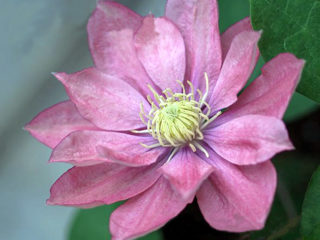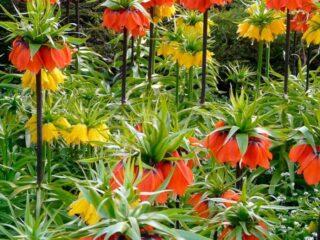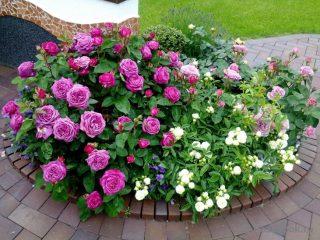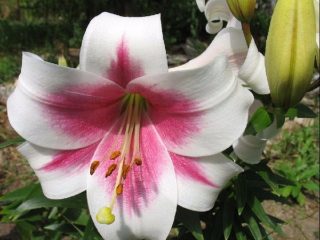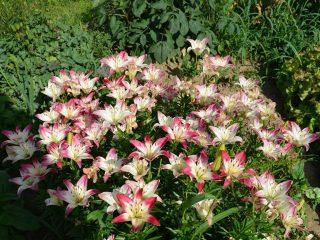Content
Designing an area with lilies in the garden requires attention. It is necessary to select the right combinations of perennials, taking into account their growing requirements and other parameters.
Design features of flower beds with lilies
Lily is a beautiful and graceful plant that emits a pleasant aroma during the flowering period. Depending on the variety, it is white, red, pink or yellow, and has cup-shaped or funnel-shaped buds.
The height of the perennial rises from 50 to 200 cm above the ground. Flowers are used in decoration:
- for creating borders;
- to form the background;
- for planting along the fence around the perimeter of the site;
- to delimit the garden into separate zones.
Tall varieties are used in individual planting and together with miniature perennials. Low lilies are used to design compact flower beds and flower beds located along paths.Miniature varieties look good on lawns and hillocks, in tree trunks.
What flowers to plant lilies with in a flower bed
Decorative lily is used in decoration along with other perennials. The culture goes well with evergreen conifers and shrubs, bright flowers. Some options are especially popular among summer residents.
Is it possible to plant lilies of different varieties side by side?
A combination of different varieties in one flowerbed is considered a successful design option. In the foreground are usually low-growing species - LA hybrids or flowers of Asian groups. It is advisable that they bloom first in late spring or early summer.
Oriental tall varieties and OT hybrids are planted in the middle of the flowerbed and in the background, flowering in July and August. Shades can be combined freely - you can choose contrasting colors or make smooth transitions between tones. When decorating a flower bed, tiers can be separated by low conifers. They will not only enhance the decorative effect, but also cover the soil and prevent it from drying out quickly.

When decorating a flower bed, lilies of different varieties are usually arranged in 2-3 tiers according to variety
Is it possible to plant lilies and daylilies nearby?
A good combination in landscape design are lilies and daylilies. The plants have a certain external similarity, but belong to different families. When planted close together, they do not cross-pollinate and do not have a negative effect on each other.
Daylilies are small compact bushes 30-100 cm high. They are usually planted in the foreground when decorating a flower bed.Lilies are placed at the back, since the flowers produce tall single stems up to 1.5-2 m above the ground and bloom in large bright buds. The decorative period lasts from July to the end of August. Each lily bud lives for about 1.5 weeks. Daylily flowers remain decorative for only one day, but at the same time they bloom alternately. In general, buds appear on the shoots within about a month.
Both cultures prefer illuminated places on the site. It should be noted that daylilies tolerate short-term drought well. However, when caring for a flowerbed after its design, you should focus on the preferences of the lily - it requires frequent watering. The flower also needs regular feeding and careful insulation for the winter.

It is necessary to use lilies together with daylilies in the design of flower beds on fertile soil
Flowerbed with peonies and lilies
Photos of peonies and lilies in the same flower bed show that the cultures combine well with each other in any design option. Low-growing flowers are placed in the foreground, tall ones are planted behind. Usually the lower tier is formed from miniature varieties that bear buds in July. The tall peonies that create the background are the first to bloom in early summer.
If desired, you can make a flower garden of three tiers and use oriental hybrids with a height of 2 m as a background. They bloom most often in early August. The decorative effect of the composition with this design option is maintained throughout the season.

The lush green foliage of peonies enhances the beauty of lilies when in bloom.
Lilies and phloxes in one flowerbed
Photos of lilies in a flower bed with other flowers demonstrate that low phloxes are often neighbors for the perennial.To design compositions, choose creeping varieties with buds of a soft lilac or blue hue. The flowerbed begins to bloom in mid-spring. By July, the glossy, juicy green of the phlox becomes a frame for the blooming lilies.

The remains of phlox greens are used in the fall as a mulching insulating layer.
Delphinium
Delphiniums look good in beds of lilies and additional flowers. Tall perennials up to 1.4 m above the ground are planted in the background, as they grow strongly. Typically, deep blue or light blue delphiniums are combined in decoration with lily bushes of white and soft pink varieties. Tall perennials create contrast and also provide cover from strong winds and bright sun.
Cultures have approximately the same care requirements. Flowers prefer loose, light soil and frequent watering; they need regular fertilizing to form abundant buds.
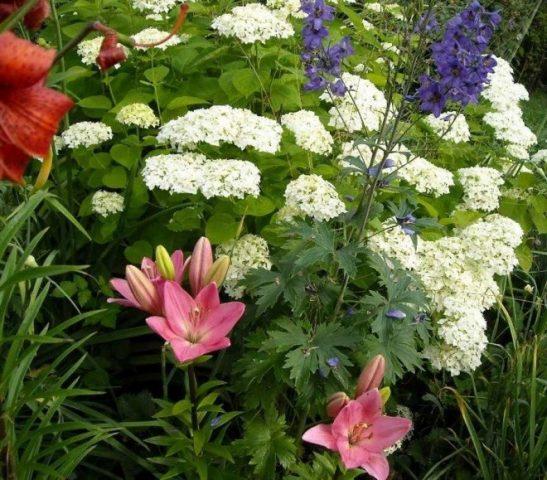
The openwork foliage of delphiniums covers the bare lily stems after the latter have finished flowering
Pyrethrum
The discreet pyrethrum cannot compete with the lily in beauty. However, the buds of the plant, similar to small daisies, successfully set off the large flowers of the decorative perennial. Pale pink varieties of pyrethrum are especially often used to decorate flower beds. The height of the crop usually does not exceed 50 cm; it is placed in the foreground of the flower garden or in the center.
Pyrethrum becomes a good neighbor for lilies in the flower bed, because it loves loose, fertile soil and has a positive attitude towards moderate moisture. The crop can be planted in sun and light shade.Pyrethrum grows abundantly and suppresses the growth of weeds - if you use it for decoration, it will be easier to care for the flower garden.
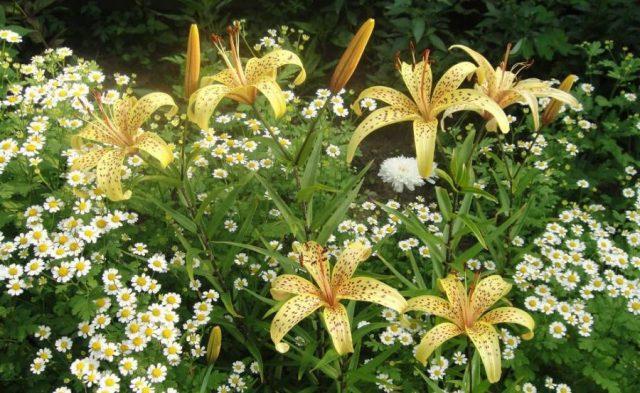
With timely removal of faded buds, pyrethrum in a lily bed can continue to bloom almost all summer
Astilbe
Lilies in the landscape look great next to astilbes - perennials up to 1.8 m tall with lacy leaves and bright paniculate inflorescences. When properly designed, the flower beds do not suppress each other, but only complement each other.
Astilbe forms tall but compact bushes and blooms with white, lilac and red panicles. It blooms for two weeks, the specific timing depends on the variety. If you choose the right plants for planting together, the decorative effect of the composition will remain throughout most of the summer.
Although astilbe has a powerful rhizome, it usually does not have a suppressive effect on the lily. Both flowers love fertile, loose soil and have similar moisture requirements. Astilbe can be planted in partial shade - this will not have a negative impact on the decorative effect of the flower bed.
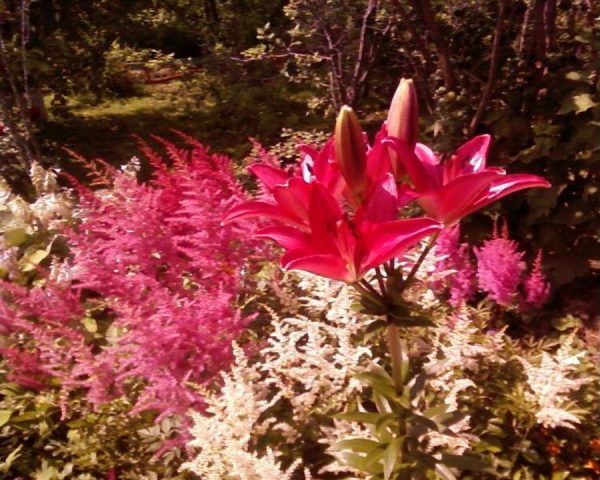
When planted in the foreground of a flower garden, astilbe will be able to cover the long bare stems of the lily with openwork leaves
Carnation
You can decorate a flowerbed with lilies using garden carnations. The plant rises up to 80 cm above the ground and bears bright double buds from early June to mid-autumn, depending on the variety.
Like the lily, carnations love sunny or slightly shaded areas in the garden. It is necessary to moisten a flowerbed with perennials moderately, focusing on the actual condition of the soil. Carnations are placed both in the background of flower beds when decorating, and in front - planting depends on the height of the plants.
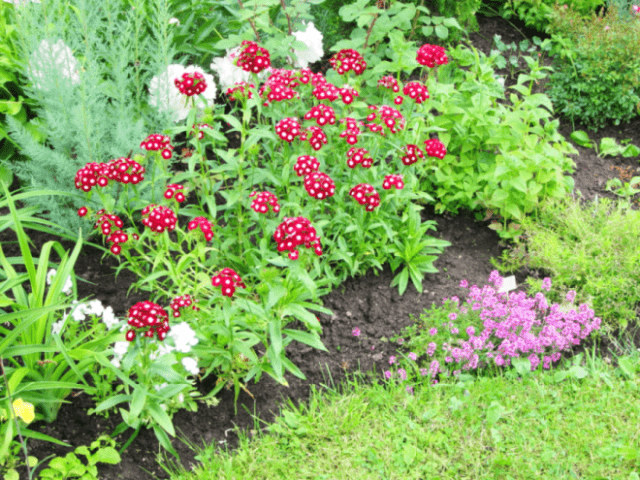
Low-growing carnations can be planted around the perimeter of the flower bed to create a flower carpet.
Yarrow
Yarrow is represented by dozens of hybrid varieties and bears pink, yellow, white, orange and red panicles consisting of small buds. Actively forms side shoots, but remains quite compact. It reaches a height of 50-90 cm and fits well with most varieties of lilies when decorating a flower bed.
Yarrow in a flower garden is usually placed in the foreground. After the lily buds wither, the perennial maintains the decorative appearance of the flowerbed, covering the exposed shoots. It is characterized by high endurance, tolerates short droughts well and does not require a lot of light.

When planting yarrow next to a lily, you need to remove faded buds in time to prevent the crop from self-seeding
What plants should not be planted with?
The proximity of lilies to other flowers is not always successful. It is better not to use some crops when designing decorative flower beds. In particular, lily bushes do not get along well:
- with irises - plants have different requirements for watering intensity;
- with tulips - cultures suffer from the same diseases and can become infected from each other;
- with daffodils - according to the requirements, the flowers are similar, but when planted close together they look rather pale.
It is not advisable to plant a lily when decorating a flower bed with perennials that have the same bud shape. Cultures will simply be lost against each other.
Is it possible to plant lilies next to roses?
Photos of roses and lilies in the same flower bed confirm that planting crops next door is not prohibited. However, in practice such compositions are rare. Both perennials are very showy; it is better to place them in landscape design next to less showy plants.
If desired, you can plant tall lilies behind low-growing climbing roses, choosing contrasting colors. Cultures highlight each other's beauty well.
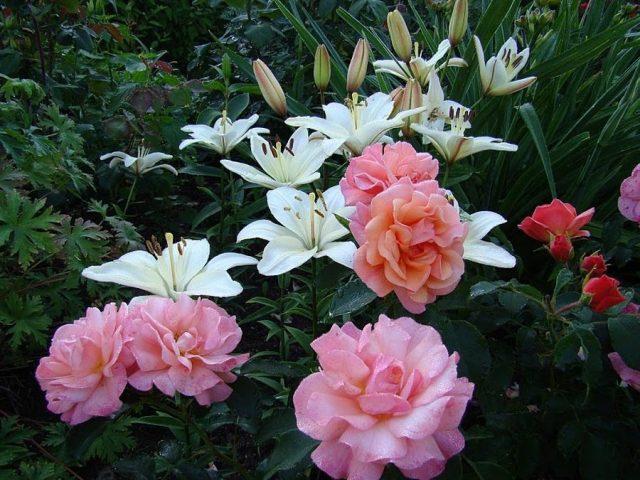
When decorating a flower bed, 5-6 lilies are planted next to the rose bush, otherwise the composition will lose its grace.
Is it possible to plant gladioli next to lilies?
Flowerbeds with gladioli and lilies are rare. The perennial of the first type bears large, bright and heavy buds, which do not look at all together with the graceful and sophisticated flowers.
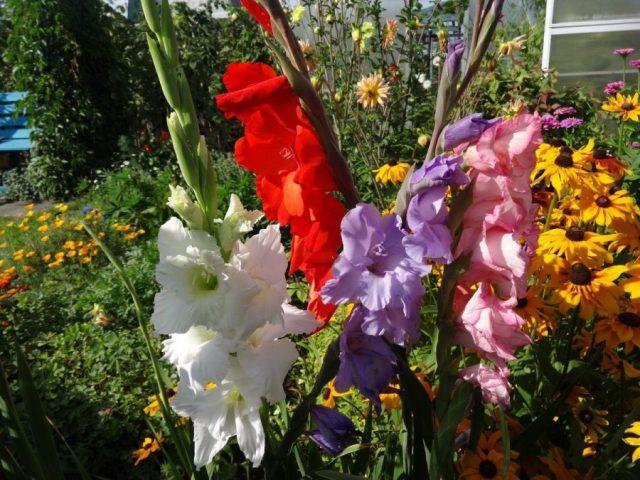
Sometimes gladioli are planted in the background of flower beds with lilies, but the colors are strictly contrasting.
Schemes and photos of beautiful flower beds with lilies
Photos of do-it-yourself lily beds show that there are several popular options for designing a flower garden. Most often, tall perennials are placed in the background in compact groups of 4-6 bushes. Flowers of medium height are planted in the center of the flower bed. Annuals or perennials up to 30 cm high are sown in front to create a colorful border.

It is better to plant lily bushes in the background of the flowerbed that are bright, with white buds
Another popular scheme suggests creating a three-layer flower bed. In the background of the flower garden there are tall plants, in particular musk or Canadian roses are well suited. Lilies with long stems are planted in front of them. Miniature varieties are placed in the foreground, which serve as an accent for the composition.
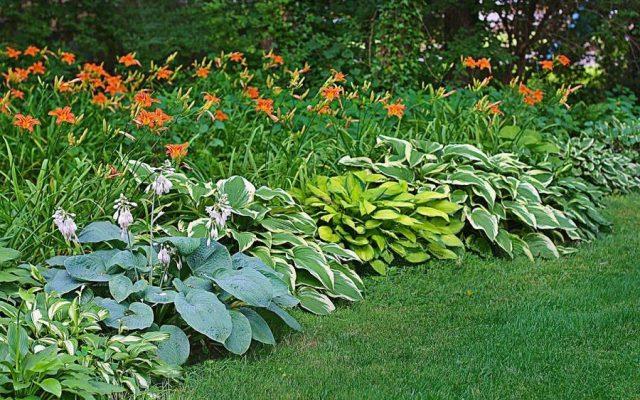
You can place a hosta around the flower bed, which will create a green frame and protect the soil from drying out.
The combination of lilies with other flowers as part of a mixborder is popular. A tall plant is planted in the center and framed with miniature perennials on both sides. In the first year, it is recommended to also sow annual crops along the perimeter, which will sprout very quickly and provide a decorative appearance to the flowerbed. In subsequent seasons, you can discard them - perennial flowers will have grown sufficiently by then.
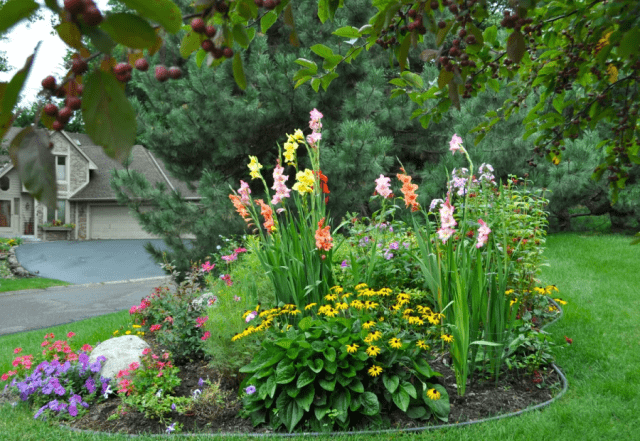
When creating a mixborder, you need to leave minimal free space between perennials.
Conclusion
Decorating an area with lilies in the garden is a very interesting creative task. The culture is compatible with most perennials, does not overwhelm its neighbors and looks harmonious next to tall and miniature flowers.


